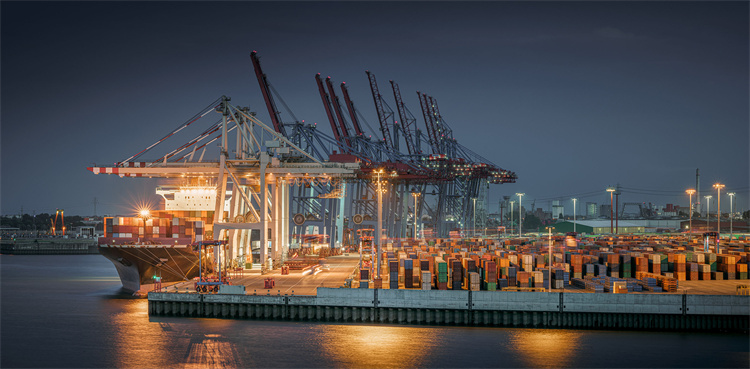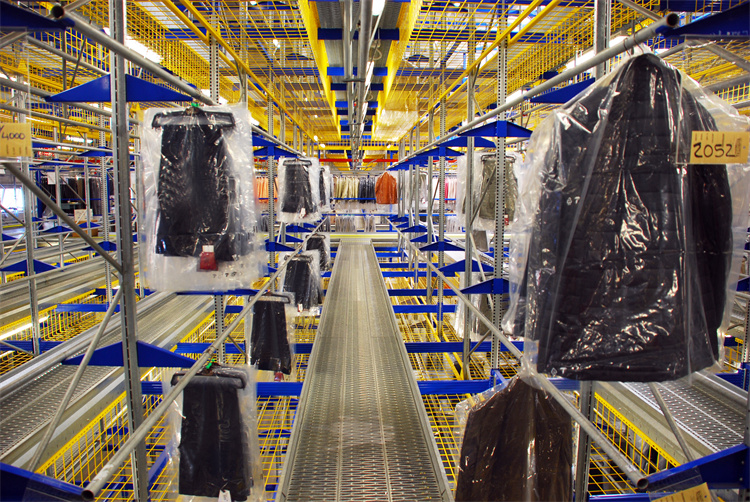Comparing Manufacturing Supply Chains in China and the USA

Manufacturing supply chains play a crucial role in the global economy. These networks ensure that products move from raw materials to finished goods efficiently. China and the USA stand out as two of the most significant players in global manufacturing. China's manufacturing sector produced about 40 percent of intermediate manufactured goods in 2018. The USA, on the other hand, is known for its high-tech supply chains. Comparing the supply chains of these two countries provides valuable insights into their strengths and challenges.
Overview of Manufacturing Supply Chains
Definition and Importance
Manufacturing supply chains consist of various steps that transform raw materials into finished products. These steps include sourcing, production, and distribution. Each step involves different players, such as suppliers, manufacturers, and logistics providers. The efficiency of these chains impacts the overall cost and quality of goods.
Key Components of Supply Chains
Key components of manufacturing supply chains include suppliers, manufacturers, and distributors. Suppliers provide raw materials and components. Manufacturers convert these materials into finished products. Distributors ensure that these products reach consumers. Efficient coordination among these components is crucial for smooth operations.
Role in Global Economy
Manufacturing supply chains play a vital role in the global economy. They enable the movement of goods across borders, supporting international trade. Efficient supply chains reduce costs and increase competitiveness. Disruptions in these chains can have significant economic impacts. Diversified inputs and strategic sourcing can make supply chains more robust.
Historical Context
The evolution of manufacturing supply chains in China and the USA reflects their unique economic histories. Both countries have developed distinct strengths and face different challenges.
Evolution in China
China's manufacturing supply chains have grown rapidly over the past few decades. The country became a global manufacturing hub by leveraging low labor costs and large-scale production capabilities. China's government policies supported industrial growth and infrastructure development. The country's manufacturing sector now plays a critical role in global supply chains.
Evolution in the USA
The USA's manufacturing supply chains have a long history of innovation and technological advancement. The country focused on high-tech manufacturing and automation. American companies invested heavily in research and development. This focus led to the creation of advanced supply chains that prioritize efficiency and quality. The USA continues to adapt its supply chains to maintain a competitive edge.
Cost and Efficiency

Labor Costs
Wage Differences
Wage differences play a significant role in manufacturing supply chains. In China, lower labor costs have historically attracted many companies. Workers in Chinese factories often earn less compared to their American counterparts. This wage gap allows Chinese manufacturers to produce goods at a lower cost. The USA, however, has higher wages due to stricter labor laws and higher living standards. These higher wages increase production costs but also ensure better worker conditions.

Impact on Production Costs
Labor costs directly impact production costs in manufacturing supply chains. Lower wages in China reduce the overall cost of manufacturing. This cost advantage makes Chinese products more competitive in the global market. In contrast, higher wages in the USA lead to increased production costs. American companies often offset these costs through automation and technological advancements. Despite higher wages, efficient processes help maintain competitiveness.
Production Efficiency
Technological Advancements
Technological advancements significantly enhance production efficiency in manufacturing supply chains. China has invested heavily in modernizing its factories. The use of robotics and automation has increased productivity. These technologies reduce the reliance on manual labor and improve precision. The USA also leads in technological innovation. American manufacturers use advanced machinery and software to streamline operations. Investments in technology help both countries improve their manufacturing capabilities.
Process Optimization
Process optimization is crucial for efficient manufacturing supply chains. Chinese factories often adopt lean manufacturing techniques. These methods focus on reducing waste and improving workflow. Efficient processes help Chinese manufacturers meet high demand quickly. In the USA, companies emphasize process optimization through continuous improvement. Techniques like Six Sigma and Total Quality Management (TQM) are common. These approaches enhance efficiency and product quality.
Technology and Innovation

Adoption of Automation
Automation has revolutionized manufacturing supply chains in both China and the USA. Factories in these countries have embraced cutting-edge technologies to enhance productivity and efficiency.
Robotics in Manufacturing
Robotics play a pivotal role in modern manufacturing supply chains. Chinese factories have integrated robots to handle repetitive tasks. This reduces human error and speeds up production. American manufacturers also use robotics extensively. Robots in the USA often perform complex tasks that require precision. Both countries benefit from increased output and reduced labor costs through robotics.
AI and Machine Learning
Artificial Intelligence (AI) and Machine Learning (ML) have transformed manufacturing supply chains. In China, AI optimizes production schedules and predicts maintenance needs. This minimizes downtime and maximizes efficiency. The USA leverages AI for quality control and supply chain management. AI algorithms analyze data to improve decision-making processes. Both nations see significant gains in efficiency and cost savings through AI and ML.
Research and Development
Investment in research and development (R&D) drives innovation in manufacturing supply chains. Both China and the USA prioritize R&D to stay competitive in the global market.
Investment in Innovation
China invests heavily in R&D to advance its manufacturing capabilities. Government policies support innovation and technological growth. American companies also allocate substantial funds to R&D. This focus on innovation leads to the development of new technologies and processes. Both countries understand that continuous investment in R&D is crucial for maintaining a competitive edge.
Collaboration with Tech Firms
Collaboration with tech firms enhances innovation in manufacturing supply chains. Chinese manufacturers often partner with local tech companies. These collaborations lead to the integration of advanced technologies in production processes. In the USA, manufacturers work closely with tech giants like Google and IBM. These partnerships foster the development of cutting-edge solutions for manufacturing challenges. Both countries benefit from the expertise and resources of tech firms.
Labor and Workforce
Workforce Skills
Education and Training
Education and training shape the workforce skills in manufacturing supply chains. In China, vocational schools focus on practical skills. These schools prepare students for factory jobs. The Chinese government invests in technical education. This investment boosts the skill level of the workforce.
In the USA, education emphasizes advanced skills. Community colleges offer specialized programs. These programs include courses in robotics and automation. American companies often provide on-the-job training. This training helps workers adapt to new technologies.
Skill Gaps
Skill gaps present challenges in both countries. In China, rapid industrial growth creates a high demand for skilled workers. Some factories face shortages of qualified technicians. This gap can slow down production.
The USA also struggles with skill gaps. Many manufacturing jobs require advanced technical skills. Not all workers have these skills. Companies sometimes find it hard to fill these positions. Efforts to close these gaps include retraining programs. These programs aim to equip workers with necessary skills.
Labor Regulations
Worker Rights and Protections
Worker rights and protections differ between China and the USA. Chinese labor laws focus on economic growth. Factories often operate under intense pressure to meet production targets. Reports of labor abuses occasionally surface. The government has made efforts to improve conditions. However, challenges remain.
In the USA, labor regulations prioritize worker rights. Laws ensure safe working conditions. Workers have the right to unionize. These protections contribute to higher labor costs. However, they also promote a stable workforce.
Impact on Supply Chain Operations
Labor regulations impact supply chain operations significantly. In China, flexible labor laws allow for rapid scaling of production. Factories can quickly increase output to meet demand. However, this flexibility sometimes comes at the cost of worker welfare.
In the USA, strict labor regulations ensure high standards. These standards can slow down production adjustments. Companies must comply with various safety and quality regulations. This compliance ensures reliable and safe products. However, it can also increase operational costs.
Regulatory Environment
Government Policies
Trade Policies
Trade policies shape the landscape of manufacturing supply chains. The USA has implemented tariffs on strategic sectors. These sectors include steel, aluminum, semiconductors, and electric vehicles. The goal is to protect American workers and companies from unfair trade practices. Tariffs increase the cost of imported goods. This encourages domestic production.
China's trade policies focus on maintaining its competitive edge. The government supports export-oriented industries. Subsidies and tax incentives help Chinese manufacturers. These policies make Chinese products more affordable in the global market. Trade tensions between China and the USA impact supply chain strategies. Companies must navigate these complexities to remain competitive.
Environmental Regulations
Environmental regulations play a crucial role in manufacturing supply chains. The USA enforces strict environmental standards. Regulations aim to reduce pollution and promote sustainability. Factories must comply with emission limits and waste management protocols. These regulations increase operational costs. However, they ensure a cleaner environment and sustainable practices.
China also enforces environmental regulations. The government has taken steps to address pollution. Factories must adhere to emission standards and waste disposal guidelines. Non-compliance can result in fines and shutdowns. Environmental regulations in China are evolving. The focus is on balancing industrial growth with environmental protection.
Compliance and Standards
Quality Control
Quality control ensures that products meet specific standards. The USA emphasizes stringent quality control measures. Factories implement rigorous testing procedures. These procedures ensure that products are safe and reliable. Quality control enhances consumer trust and brand reputation.
China also prioritizes quality control. Factories follow international standards to meet global demand. Quality control processes include inspections and testing. Consistent quality helps Chinese products compete in the global market. Both countries understand the importance of maintaining high-quality standards.
Safety Standards
Safety standards protect workers and consumers. The USA enforces strict safety regulations. Factories must comply with safety protocols. These protocols include proper equipment usage and hazard management. Compliance reduces workplace accidents and ensures product safety.
China has made significant strides in improving safety standards. The government enforces regulations to protect workers. Factories must adhere to safety guidelines. Inspections ensure compliance with safety standards. Improved safety measures enhance worker welfare and product reliability.
In summary, regulatory environments in China and the USA shape manufacturing supply chains. Trade policies, environmental regulations, quality control, and safety standards play vital roles. Companies must navigate these regulations to maintain competitiveness and ensure compliance.
China and the USA exhibit distinct strengths in manufacturing supply chains. China excels in cost efficiency due to lower labor costs. The USA leads in technological innovation and high standards. Both countries invest heavily in automation and research.
Global businesses must navigate these differences. Companies should diversify supply chains to mitigate risks. Strategic planning can help manage future disruptions.
Future trends indicate a shift towards more resilient and diversified supply chains. Businesses should prepare for economic shocks through improved communication and redundancy. Embracing these strategies will ensure a robust and competitive manufacturing landscape.
See Also
Efficient Strategies for Supply Chain Challenges in High-Tech Manufacturing
Delving into Global Consumer Needs: Jusda's Supply Chain Analysis
Revolutionizing Supply Chains with Robotics Innovation
Achieving Success in High-Tech Manufacturing through Lean Logistics
